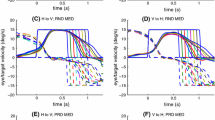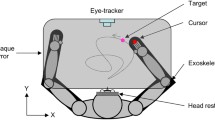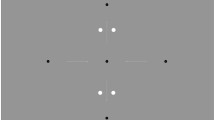Abstract
Smooth pursuit tracking of targets moving linearly (in one dimension) is well characterized by a model where retinal image motion drives eye acceleration. However, previous findings suggest that this model cannot be simply extended to two-dimensional (2D) tracking. To examine 2D pursuit, in the present study, human subjects tracked a target that moved linearly and then followed the arc of a circle. The subjects’ gaze angular velocity accurately matched target angular velocity, but the direction of smooth pursuit always lagged behind the current target direction. Pursuit speed slowly declined after the onset of the curve (for about 500 ms), even though the target speed was constant. In a second experiment, brief perturbations were presented immediately prior to the beginning of the change in direction. The subjects’ responses to these perturbations consisted of two components: (1) a response specific to the parameters of the perturbation and (2) a nonspecific response that always consisted of a transient decrease in gaze velocity. With the exception of this nonspecific response, pursuit behavior in response to the gradual changes in direction and to the perturbations could be explained by using retinal slip (image velocity) as the input signal. The retinal slip was parallel and perpendicular to the instantaneous direction of pursuit ultimately resulted in changes in gaze velocity (via gaze acceleration). Perhaps due to the subjects’ expectations that the target will curve, the sensitivity to the image motion in the direction of pursuit was not as strong as the sensitivity to image motion perpendicular to gaze velocity.













Similar content being viewed by others
References
Bahill AT, McDonald JD (1983) Smooth pursuit eye movements in response to predictable target motions. Vis Res 23:1573–1583
Baloh RW, Yee RD, Honrubia V, Jacobson K (1988) A comparison of the dynamics of horizontal and vertical smooth pursuit in normal human subjects. Aviat Space Environ Med 59:121–124
Barnes GR (1982) A procedure for the analysis of nystagmus and other eye movements. Aviat Space Environ Med 53:676–682
Barnes GR, Barnes DM, Chakraborti SR (2000) Ocular pursuit responses to repeated, single-cycle sinusoids reveal behavior compatible with predictive pursuit. J Neurophysiol 84:2340–2355
Bennett SJ, Barnes GR (2003) Human ocular pursuit during the transient disappearance of a visual target. J Neurophysiol 90:2504–2520
Bennett SJ, Barnes GR (2004) Predictive smooth ocular pursuit during the transient disappearance of a visual target. J Neurophysiol 92:578–590
van den Berg AV (1988) Human smooth pursuit during transient perturbations of predictable and unpredictable target movement. Exp Brain Res 72:95–108
Carey MR, Lisberger SG (2004) Signals that modulate gain control for smooth pursuit eye movements in monkeys. J Neurophysiol 91:623–631
Churchland MM, Lisberger SG (2001) Experimental and computational analysis of monkey smooth pursuit eye movements. J Neurophysiol 86:741–759
Churchland AK, Lisberger SG (2002) Gain control in human smooth-pursuit eye movements. J Neurophysiol 87:2936–2945
Collewijn H,Tamminga EP (1984) Human smooth and saccadic eye movements during voluntary pursuit of different target motions on different backgrounds. J Physiol (Lond) 351:217–250
Dallos PJ, Melvill-Jones RW (1963) Learning behavior of the eye fixation control system. IEEE Trans Autom Contr AC 8:218–227
Deno DC, Crandall WF, Sherman K, Keller EL (1995) Characterization of prediction in the primate visual smooth pursuit system. Biosystems 34:107–128
de’Sperati C, Viviani P (1997) The relationship between curvature and velocity in two-dimensional smooth pursuit eye movements. J Neurosci 17:3932–3945
Engel KC, Soechting JF (2003) Interactions between ocular motor and manual responses during two-dimensional tracking. Progr Brain Res 142:141–153
Engel KC, Anderson JH, Soechting JF (1999) Oculomotor tracking in two dimensions. J Neurophysiol 81:1597–1602
Engel KC, Anderson JH, Soechting JF (2000) Similarity in the response of smooth pursuit and manual tracking to a change in the direction of target motion. J Neurophysiol 84:1149–1156
Fender DH (1971) Time delays in the human eye tracking system. In: Bach-y-Rita P, Collins CC, Hyde JE (eds) The control of eye movements. Academic, New York
Huebner WP, Leigh RJ, Seidman SH, Thomas CW, Billian C, DiScenna AO, Dell’Osso LF (1992) Experimental tests of a superposition hypothesis to explain the relationship between the vestibuloocular reflex and smooth pursuit during horizontal combined eye–head tracking in humans. J Neurophysiol 68:1775–1792
Keller EL, Heinen SJ (1991) Generation of smooth-pursuit eye movements: neuronal mechanisms and pathways. Neurosci Res 11:79–107
Kettner RE, Leung HC, Peterson BW (1996) Predictive smooth pursuit of complex two-dimensional trajectories in monkey: component interactions. Exp Brain Res 108:221–235
Kowler E (1989) Cognitive expectations, not habits, control anticipatory smooth oculomotor pursuit. Vis Res 29:1049–1057
Kowler E, Steinman RM (1981) The effect of expectations on slow oculomotor control-III. Guessing unpredictable target displacements. Vis Res 21:191–203
Kowler E, Martins AJ, Pavel M (1984) The effect of expectations on slow oculomotor control-IV. Anticipatory smooth eye movements depend on prior target motions. Vis Res 24:197–210
Krauzlis RJ (2004) Recasting the smooth pursuit eye movement system. J Neurophysiol 91:591–603
Krauzlis RJ, Lisberger SG (1989) A control systems model of smooth pursuit eye movements with realistic emergent properties. Neur Comput 1:116–122
Krauzlis RJ, Lisberger SG (1994a) A model of visually-guided smooth pursuit eye movements based on behavioral observations. J Comput Neurosci 1:265–283
Krauzlis RJ, Lisberger SG (1994b) Temporal properties of visual motion signals for the initiation of smooth pursuit eye movements in monkeys. J Neurophysiol 72:150–162
Krukowski AE, Stone LS (2005) Expansion of direction space around the cardinal axes revealed by smooth pursuit eye movements. Neuron 45:315–323
Leung HC, Kettner RE (1997) Predictive smooth pursuit of complex two-dimensional trajectories demonstrated by perturbation responses in monkeys. Vis Res 37:1347–1354
Lisberger SG, Evinger C, Johanson GW, Fuchs AF (1981) Relationship between eye acceleration and retinal image velocity during foveal smooth pursuit in man and monkey. J Neurophysiol 46:229–249
Lisberger SG, Morris EJ, Tychsen L (1987) Visual motion processing and sensory-motor integration for smooth pursuit eye movements. Annu Rev Neurosci 10:97–129
Meyer CH, Lasker AG, Robinson DA (1985) The upper limit of human smooth pursuit velocity. Vis Res 25:561–563
Mrotek L (2005) Influence of direction during target tracking. PhD Thesis, University of Minnesota, p 274
Mrotek LA, Flanders M, Soechting JF (2004) Interception of targets using brief directional cues. Exp Brain Res 156:94–103
Robinson DA, Gordon JL, Gordon SE (1986) A model of the smooth pursuit eye movement system. Biol Cybern 55:43–57
Roitman AV, Massaquoi SG, Takahashi K, Ebner TJ (2004) Kinematic analysis of manual tracking in monkeys: characterization of movement intermittencies during a circular tracking task. J Neurophysiol 91:901–911
Rottach KG, Zivotofsky AZ, Das VE, Averbuch-Heller L, Discenna AO, Poonyathalang A, Leigh RJ (1996) Comparison of horizontal, vertical and diagonal smooth pursuit eye movements in normal human subjects. Vis Res 36:2189–2195
Schwartz JD, Lisberger SG (1994) Initial tracking conditions modulate the gain of visuo-motor transmission for smooth pursuit eye movements in monkeys. Vis Neurosci 11:411–424
Soechting JF, Mrotek LA, Flanders M (2005) Smooth pursuit tracking of an abrupt change in target direction: vector superposition of discrete responses. Exp Brain Res 160:245–258
Acknowledgements
We thank Dr. Stephen Lisberger for his helpful suggestions during the course of this work and his comments on an earlier version of this manuscript. Timothy Miller assisted in some of the data analysis. This work was supported by NIH Grant EY-13704.
Author information
Authors and Affiliations
Corresponding author
Rights and permissions
About this article
Cite this article
Mrotek, L.A., Flanders, M. & Soechting, J.F. Oculomotor responses to gradual changes in target direction. Exp Brain Res 172, 175–192 (2006). https://doi.org/10.1007/s00221-005-0326-1
Received:
Accepted:
Published:
Issue Date:
DOI: https://doi.org/10.1007/s00221-005-0326-1




